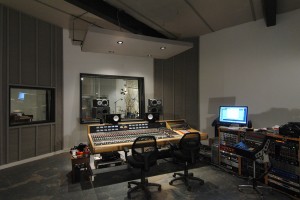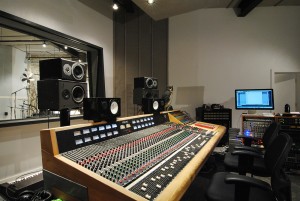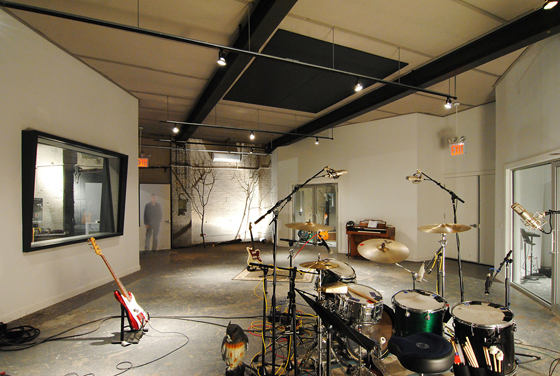New Studio Alert: Room 17 in Bushwick, Brooklyn
When Adam Lasus decided to partner up with Joe Rogers and Scott Porter at the new Room 17 in Brooklyn, it was something of a homecoming. Until high rents and new opportunities convinced him and his wife to move to LA in 2006, Lasus had run his Fireproof Recording Studio Ghostbusters-style, out of a converted 19th century firehouse in Red Hook. Between that space and an even earlier studio in Philly, Lasus had worked with a long line of indie rock artists like Helium, Yo La Tengo, Ben Harper, Dawn Landes, Matt Keating, and Clap Your Hands Say Yeah.
Although his own personal studio and Neotek Elan console still live on the West Coast, Lasus seems thrilled to be commuting back east, sometimes staying for a week or more in order to work on projects in this new room. When we met, he was in town to record a new solo album for a songwriter named Aaron Lee Tasjan. “In L.A. there are maybe 20, 30 really awesome indie bands doing great things,” Lasus says. “Here in Brooklyn there are that many on this block.”
Lasus is a youthful-seeming 44. He’s ginger-haired and gregarious, with a charming, almost boyish sense of enthusiasm for both his tools and for the people he records with. One of those people is Joe Rogers, a young label-owner, songwriter, and a former client who now runs day-to-day operations at Room 17 and engineers the bulk of the sessions. Rogers started putting out records over 10 years ago, working out of a makeshift studio in the Bronx, and has recorded with artists like The Shivers and Kelli Scarr.
The two of them sit together for an extended interview in a cavernous yet surprisingly well-controlled mix room, and occasionally finish each other’s thoughts and sentences. They share some central ideas: That trust and camaraderie are the most important aspects of the client/engineer relationship; That digital is fine but tape is more fun; And that smashing mic signals through cheap old transistor stereos is a badass thing to do.
Unable to make this meeting is a third partner, the musician and investor Scott Porter. Like Rogers, he’s a close friend and former client of Lasus’, who has made the transition from performer to producer/engineer in his own right.
When I stop by, he’s off tending to his other businesses – a pair of nearby Bushwick venues called “The Wick” and “The Well.”
Room 17 sits on a revitalizing Bushwick block, part of a once-industrial strip close to the border of East Williamsburg. The studio is located just down the street from local “DIY” venue The House of Yes, and not far from 3rd Ward, Shea Stadium, The Sweatshop, and essentially, the whole burgeoning Bushwick art and music scene.
As I walk toward their building, I pass an old minibus, parked about dozen yards from their door. It’s spray-painted in technicolor graffiti and stuffed full of the Brooklyn equivalent of hippies (presumably psych-folk fans) brandishing iPhones and acoustic guitars. They’re perhaps indicative of this new Bushwick, although by no means emblematic of it.
As austere and industrial as the area might seem to the outside eye, the three studio partners still had a hell of a time finding a 10 year lease here (perhaps one of the only arrangements that really makes sense for a fairly high-cost, low-profit business like an affordable music studio.) New York landlords know the deal: Once the artists start moving in, residential rents start going up, and soon after, commercial rents will follow. In real life, just as in the online world, art and culture are perhaps among the biggest drivers of perceived value and economic growth. (If only more artists knew how to capitalize on that).
The inside of the studio mirrors the area itself. It’s a large warehouse space that blends thrifty professionalism with a sensible minimalist build. Rather than re-imagining the concrete raw space, the studio instead re-purposes it, keeping much of the site’s lofty, wide-open appeal intact.
Each of the rooms is huge, and somewhat spare, with stone floors and a few strategically placed carpets. But they are also unexpectedly well-balanced. There’s barely a parallel wall in the whole place, and the 14-foot-high ceilings are stuffed full of 6-12 inches of insulation, practically eliminating the need for additional trapping. Otherwise all that’s there is cement, glass and drywall, allowing the space to retain some subtle reflections that make the room sound airy and alive.
The main tracking space is enormous on its own, and it connects to two ample iso booths that are larger than some other studios’ live rooms. Even the control room by itself is bigger than many Brooklyn apartments. All these spaces are linked by immense glass doors, and downstairs there’s a makeshift echo chamber that sometimes doubles as an additional live room. Put together, it’s well over 3,000 square feet of recording space.
Gear at Room 17 is as distinctive as the space. The console is a rare Trident – an early 80 series refurbed with a newly upgraded master section. The main recorder is an equally unusual 2” Otari, once property of Manhattan’s legendary Unique Recording Studios, and it comes equipped with both the 24- and 16-track headstacks.
Naturally, there’s also a Pro Tools HD rig, and an island of rack gear is stuffed with some interesting and esoteric pieces from Valley People, Manley, ADR, TapCo, Focusrite, MXR, Allison Research and Symetrix. The mic locker is full of vibey old dynamics and some great-sounding, cost-effective mics from Peluso, Gefell, AKG, Oktava, Michael Joly Engineering and Mojave.
The idea here is to keep things affordable while offering a larger, less intimidating space that bands might otherwise find in a similar price bracket. To Lasus, one of the few challenges is helping the kinds of bands he loves working with understand that they can afford to work with him:
“A lot of bands will see something like Clap Your Hands Say Yeah on my discography and just assume we’re going to be too expensive,” he says when the subject of rates comes up. But what they tend to forget is that when Lasus recorded them, CYHSY were just like so many other Brooklyn bands: unknown and inexperienced weekend warriors, uncertain about just what to expect from some of their first real studio dates.
Lasus recalls giving their drummer Sean Greenhalgh a beer early on in their first session. They had been nervous about playing earlier in the day than usual, and that move seemed to set him at ease.
It was a way of communicating something Lasus tries to make clear in every session, one way or the other: Getting great recordings isn’t about judging the artists. It’s about understanding them. It’s about making them feel relaxed and capturing them in their most natural and un-reflexive state.
If there’s some deeper purpose to all Lasus’ high-spirited chatter and convivial energy, it’s probably that.
Justin Colletti is a Brooklyn-based audio engineer, college professor, and journalist. He records and mixes all over NYC, masters at JLM, teaches at CUNY, is a regular contributor to SonicScoop, and edits the music blog Trust Me, I’m A Scientist.
Please note: When you buy products through links on this page, we may earn an affiliate commission.










